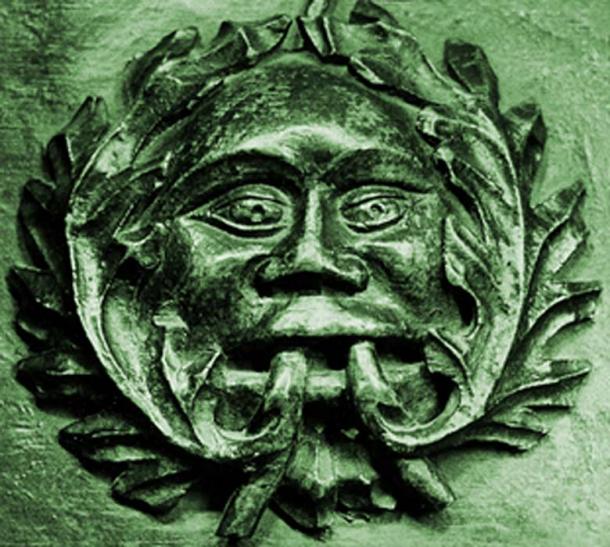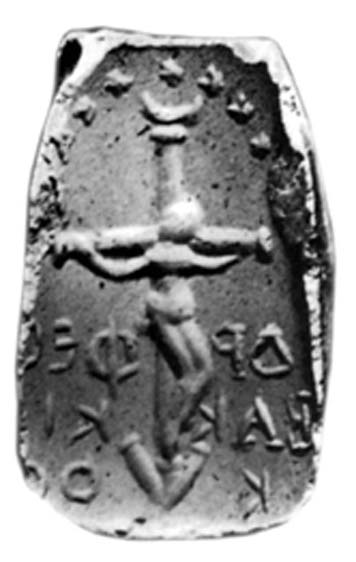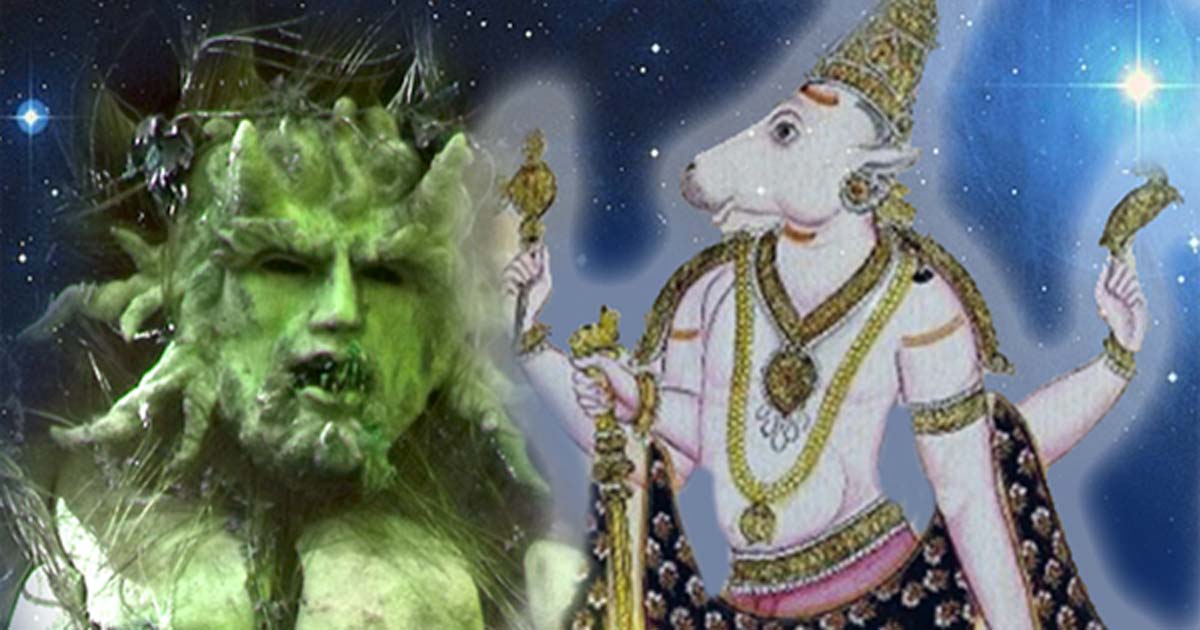From Green Man to Bull Son, The Universal Shaivite Bull Cult – Part I
In ancient times a new culture suddenly exploded across the vast terrain of Asia, Europe and Africa that was an evolution of the primeval Goddess Culture of the Neolithic Age that had previously existed for many thousands of years. That earlier agrarian, nature-worshipping culture had featured the Earth Goddess and Her Son, the Green Man, who was annually born as all the new forms of nature in the spring and then died with the falling leaves and rotting plants each autumn. Observation of the seven stars of the Pleiades was an essential part of this early Nature Religion; their rise in the spring and their descent in autumn divided the year into two parts and corresponded closely to the life and death cycle of the Green Man.

The Green Man. (Simon Garbutt/Public Domain)
When the new culture arrived, the Green Man acquired horns, and he became intimately associated with the virile bull. The Pleiades has also acquired bovine associations and became part of the Zodiacal sign of the Bull Son, Taurus. A new complete culture, known as the Bull Cult had emerged. Also referred to as the primeval Shaivite Culture because its underpinnings closely resembled what would later become the modern Shaivite Culture in India, this new cult quickly became a universal religion and succeeded in uniting the Asian, European, and African peoples known as the Babylonians, Greeks, Egyptians, Celts, Persians, Anatolians and more.

Nandi (Bull), a gate-guardian deity which also serves as the mount to the god Shiva. (Ms Sarah Welch/CC BY-SA 4.0)
Some features of the Shaivite-Bull Cult were adopted by many new and ancient civilizations around the globe. How each of these elements was absorbed by the member countries of this cult will be covered in order and in full detail.
The Goddess and Her Bull/Horned Son
In Asia, Europe and Africa the Bull Son was the centerpiece of the Shaivite-Bull Cult and known variously as Marduk (Babylonia), Zagreus-Dionysus (Greece), Ptah-Osiris (Egypt) and the horned Pashupati, the “Lord of the Animals,” of the Indus Valley Civilization of India. Pashupati has been called an early form of Lord Shiva, but he could also be a manifestation of Shiva’s Son, Murugan, who was and is a manifestation of the Neolithic Green Man. At his contemporary headquarters at Kataragama on Sri Lanka, Murugan’s venerated titles currently include al-Khadir, meaning the “Green Man.” And in ancient times, when the soldiers of Alexander the Great beheld the Sri Lankan Murugan they identified him as their Green Man, Dionysus. Later, when these soldiers returned to their native Greece they communicated their discovery to Ptolemy, the world’s first map maker, who then referred to Kataragama on his maps as Bachi oppidum, the “Land of Bacchus (i.e., Dionysus).”

Ptolemy’s Map of Bachi oppidum.
Special Note: In regard to the spreading of the Bull Cult across Asia to Egypt, it is important to recognize the undeniable India-Egypt link that helped trigger it. The Bull Gods that manifested at these two extreme ends of the Asia-African Shaivite-Bull Cult as Ptah-Osiris (Egypt) and Pashupati-Shiva-Murugan (India) possessed so many similarities in their respective characters that the missionaries of the Shaivite-Bull Cult must have either taken the image and rites of Ptah-Osiris to India or those of Pashupati-Shiva-Murugan to Egypt. Or perhaps both lines of influence were in operation. In apparent confirmation that such a line of influence existed, the Roman historian Plutarch quotes the legend of Osiris, whom he maintains completely encircled the world while spreading the rites involved with the sacred Bull Cult. And the Greek historians were adamant that Osiris’ counterpart Dionysus had carried the sacred rites from his native Greece to Nyssa in India.
- The Sacred Ensembles of the Hoysala
- 10,000-Year-Old Telescopes? Ancient Tombs May Have Enhanced Visibility of Astronomical Phenomena
- Taking the Bull by the Horns: The Perilous Minoan Practice of Bull-Leaping
- The Egyptian Goddess Isis, Found in India
The myriad similarities that existed between these two Bull Gods include: Both Ptah-Osiris and Shiva-Murugan-Pashupati were venerated as both the Green Man and Lord of Fire in Egypt and India respectively. In Egypt, Ptah-Osiris was the spirit that incarnated as a live bull, the sacred Apis Bull; and in India, Shiva was intimately associated with the spirit that animated his sacred bull, Nandi. Moreover, the consorts of Ptah-Osiris and Shiva-Murugan-Pasupati also reveal their special connection. The wife of Ptah was Sekhmet, meaning the “Power,” and Shiva’s consort was Shakti, a name that is also translated as “Power.”
The Pleiades and the Zodiac sign of Taurus the Bull

Taurus the Bull constellation (Public Domain)
Within all those countries where astronomy and astrology were practiced during the Bull Cult, the Pleiades was included in the celestial bull within its hump and the Seven Sisters thereby became part of the Zodiacal sign of Taurus. In this cosmic position the Pleiades were said to be the Goddess who transcended and gave birth to (or emanated) Her Son, the Bull Taurus. Or, by a second and third perspective, the belief was commonly held throughout the countries of the Shaivite-Bull Cult that the Seven Sisters were the Nurse Maids of the Bull Son…and/or that the Pleiades by itself was an asterism that represented the Bull Son.
Murugan-Karttikeya, the Fiery Celestial Warrior
In India, the Pleiades were both the Krittikas, the nurse maids of Murugan, as well as Karttikeya himself. The name Krittika denotes “Sword of Fire” and thus associates the Pleiades with Murugan-Karttikeya, the fiery celestial warrior. Murugan is also undeniably associated with the Pleiades through another name of the asterism, Kartika or Kartik - which is a shortened a version of the name Karttikeya. As Karttikeya, Murugan is often represented with six heads that, among their many associations, represent the six visible stars of the Pleiades asterism.

Six Headed Karttikeya.
Murugan’s Greek counterpart, Dionysus was also intimately associated with the Seven Sisters, who were identified as his seven nurse maids. As the beastly Zagreus, Dionysus’ followers on Earth regularly feted and honored their deity as the Greece and Cretan manifestation of the Bull Son. On Crete, just as it was the custom in other countries of the Bull Cult, such as Babylonia and Persia, the ruling priest-king was recognized to be an incarnation of the Bull Son. Above his Cretan throne rested the two-headed battle axe, or labyrs, which as a symbol of the king’s mother, the Goddess, represented the authority under which the monarch ruled. The Cretan king was descended from an ancient line of Bull Son monarchs whose lineage extended back to the era of the Green Man. His Bull Cult lineage had arrived on Crete via Anatolia, the country whose manifestation of the Bull Cult was thriving as early as 6000 BCE.

Crucified Dionysus with the 7 Pleiades overhead.
Mithra, the Warrior Son
In Persian, the Shaivite-Bull Cult featured Mithra, the Warrior Son who was the Persian counterpart of Karttikeya and Dionysus. When his version of the Bull Cult traveled west to the Middle East, Mithra became Mithras, a hero who was intimately associated with the bull. He could take the form of a bull, but most commonly he was identified as the bull’s sacrificer. Mithraism, which was intimately tied to astrology, associated the sacred bull with Taurus, the Celestial Bull, and its sacrificer Mithras with the constellation of the Hunter, Orion.
- The Kailash temple at Ellora – preserving ancient wisdom for mankind
- Important 800-Year-Old Jain Inscription Uncovered in India
- From the Ancient Greek Pleiades to the Hindu Matrikas: Mother Goddesses, Music and the Sacred Number 7
It was believed that at certain times of the year the cosmic Mithras would sacrifice the celestial bull and release its lifeforce power to help further create and feed the physical universe. Meanwhile, during this sacred time on Earth, a physical bull was sacrificed in the temples of Mithras so its divine and purifying blood and enriching life force power could shower down upon those candidates seeking initiation into the sect.

Mithras killing the bull (c. 150 CE). (Serge Ottaviani/CC BY-SA 3.0)
The association with the bull and the Pleiades was also known among the Yezidis of northern Iraq, who during their Autumn Festival – when the Pleiades were directly overhead in the night sky – sacrificed specially selected bulls. Another reason they honored the appearance of the Seven Sisters with special rites at this time was because it was also the court of their primary deity, the Peacock Angel, the Yezidis’ “Son of God” who also had a special association with both the Seven Sisters and the Bull Son.
[Read Part II: Alchemy and Generating Lifeforce —Global Temples Made in the Shape of Lingams: Shaivite Bull Cult]
--
Mark Amaru Pinkham is an internationally known author and researcher. He currently lives in Sedona, Arizona where he teaches ancient, esoteric history while overseeing the Order and Mystery School of the Seven Rays and leading sacred pilgrimages around the globe for Sacred Sites Journeys. SevenRayOrder.com | SacredSitesJourneys.com
A revised edition of his book The Return of the Serpents of Wisdom– Special Edition is now available.
Top image: Green Man (ElliotBrown/CC BY 2.0) and Bull Nandi (Public Domain)/Deriv.


















Comments
Hi Mark, good article. I have identified similar references, my area of interest is in Minoa and technology specifically. These references may also be referring very specifically to the astronomical age when Taurus is on the constellation facing East at the spring equinox, from 4000 – 2000 BC (depending on how you interpret the constellation boundaries), but importantly around the ages your referring to. Some cultures are marking ages very specifically with idols and in some cases in monolithic structures also (it's an obvious way to mark celebrate the age your in). A lot of the mythology is actually referring to killing off one zodiac sign to bring in a new age, this is also true of changes in pole stars due to precession.
I may be able to clarify some of the Minoan deities and culture. They have four, if you look carefully at other cultures they also have the same number but the genders do change. What’s interesting is that the Minoans keep true to their four over time and applied new attributes to the appropriate deity, where the Egyptians by example, had many deities each having more distinct attributes. For the Minoans specifically: Mother (earth), twins: daughter (moon) and Son (sun) and consort (Venus), those that organise. This very simple system allows them to express respectively: seasons (winter, autumn, summer and spring), time (midnight, sunset, midday and sunrise) and direction (North, West, South and East). It is easy to spot once you understand the system in Minoan iconography because they had a practical need to teach navigation. Each of the four houses had a corresponding Priestress.
The Wanax seems to be in charge of society and probably directed the priestesses, probably through a mother superior, the one with the snakes. It is unclear if the Wanax (Minos) was appointed by birthright or talent, possible by trial in the Bull leaping arena (‘Minos was last to leave’), so may explain the half man and bull references. The Minoans do not have priests, but when transferred to other masculine cultures such as the Spartans they do. The so called snake goddess, is simply the embodiment of mother Earth, she points to Thuban the ‘snake’ and pole star, and the snake bearer constellation is directly overhead in her season winter (when the society is calling upon her food stores).
Labyr are grossly misunderstood, they are angular measurement and navigational tools, they are used with the so called ‘horns of consecration’ to track the suns position, so to a degree can be associated with the bull. Hope this helps in your research area, you will spot may references to this, the iconography of this region at this time has similar underlying meaning, it is not exactly the same, but is very similar. BTW the sister in law (Venus/Aphrodite-East) and (Mistress of Animals/Artemis/Athena- West), get confused somewhat, I can’t explain this, it is as if they are swopped in some cultures. It may be that some of the references get confused, Artemis was nurse to Apollo’s offspring rather than incestuous. The sisters in law generally have birds associated with them, a dove and owl when referring to direction, when together passing over from one domain to another, life (light) to the underworld (night) for example. I entirely agree with the association with constellations the ancients were monitoring star and celestial bodies on a daily basis, they were astronomers, I firmly believe they knew a lot about how the solar system actually works from study over a very long period of time, the griffins guard the cone that the world wobbles within due to precession for example, which suggests that they were monitoring this for a long time. They where actually very scientific and the maths is amazing: fractional trigonometry that they had, it is jaw dropping good and almost certainly how they where measuring positions accurately and predicting such things as eclipses.